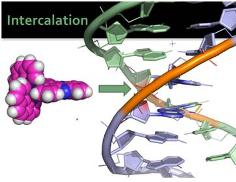Research sheds new light on kinky DNA
Release Date 25 June 2012

A breakthrough in DNA research from the University of Reading could be used to devise new therapeutic treatments for cancer.
Professor Christine Cardin, from the Department of Chemistry, has seen for the first time how one group of metal-containing molecules interacts with DNA. The molecules create new steps in its structure that fluoresce or glow under the microscope. This sheds new light on how and why our DNA changes shape.
The double helix could be justifiably called a scientific icon. Graphics showing the intertwined strands are used to market everything from hair shampoo to high-tech medical equipment. Yet we know remarkably little about exactly how molecules which are known to bind to DNA change its structure.
The new work, reported in Nature Chemistry, has overturned a widely held assumption that these important molecules cause extra steps within a DNA stack from what is called the major groove running along the double helix; however Professor Cardin has shown that they use the minor groove, and in doing so, fluoresce.
She said: "We now know that when molecules bind to DNA symmetrically within the minor groove they can't form other interactions, while those which go in at an angle can, linking to further segments of DNA and creating a kink. How molecules bind to DNA is important for designing probes for specific DNA sequences. Many genes are switched on and off when the right protein creates a kink in the DNA double helix, and a drug which could do this selectively could be a used to further medical research.
"This kinking behaviour probably occurs with other molecules, but this is the first time it has been directly visualized with a small molecule."
The paper, ‘Crystal structures of L-[Ru(phen)2dppz]2+ with oligonucleotides containing TA/TA and AT/AT steps show two intercalation modes', by Niyazi, H, Hal, J.P., O'Sullivan, K., Sorensen, T, Winter, G, Kelly, J.M. and Cardin, C.J, appears in Nature Chemistry, DOI: 10.1038/NCHEM.1397
See Professor Cardin's video at http://youtu.be/KQC4raxSQf4
ENDS
For more information please contact Rona Cheeseman, research communications manager, on 0118 378 7388 or email r.cheeseman@reading.ac.uk
